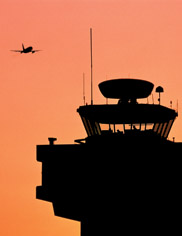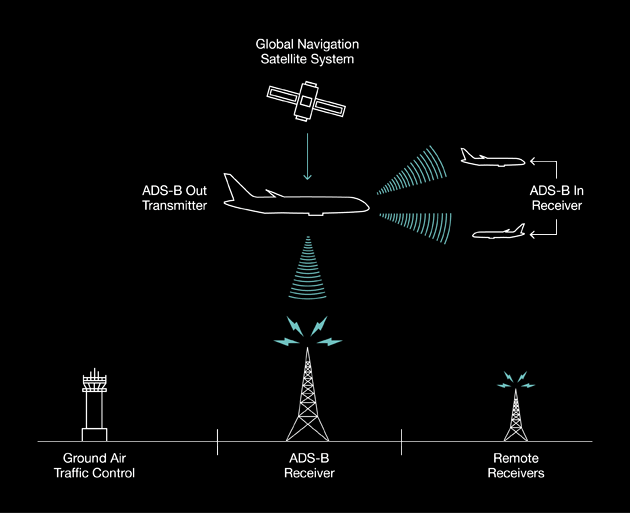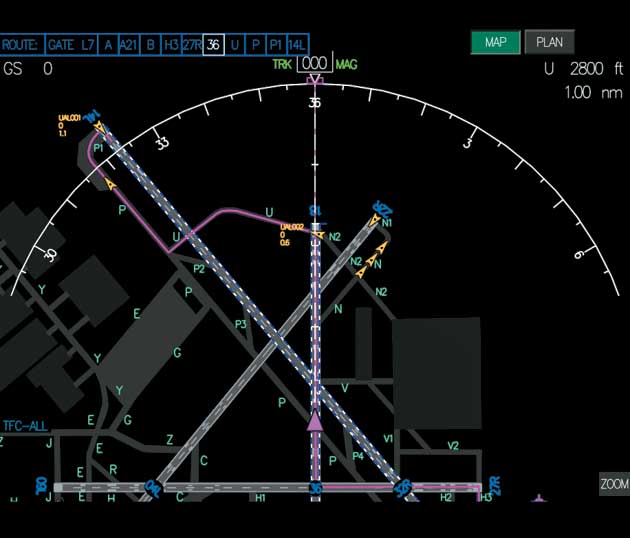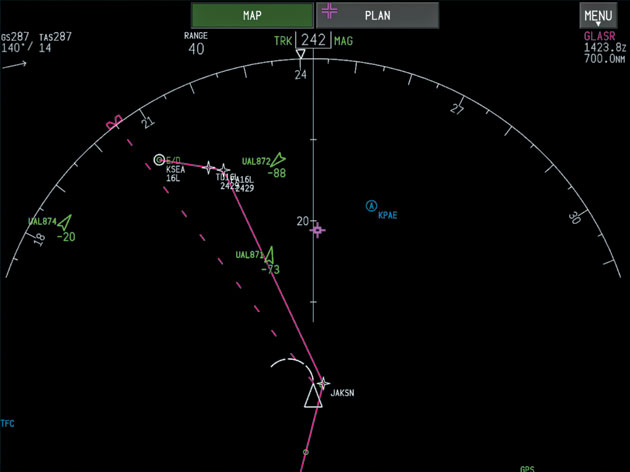

Air traffic service providers and regulators around the world are moving toward airspace and flight operations to enable greater flexibility and adaptability, along with assuring improved traffic flow, capacity, efficiency, and safety. A key part is the transition from radar surveillance to Automatic Dependent Surveillance-Broadcast (ADS-B) to track airplanes in flight and on the ground more accurately and reliably. The changes will require new equipage on Boeing airplanes in production as well as those already in service.
By William R. Richards, Technical Fellow, Avionics and Air Traffic Management;
Kathleen O’Brien, Associate Technical Fellow, Avionics and Air Traffic Management; and
Dean C. Miller, Associate Technical Fellow, Avionics and Air Traffic Management
ADS-B is intended to transform air traffic control by providing more accurate and reliable tracking of airplanes in flight and on the ground.
ADS-B is a new surveillance technology designed to help modernize the air transportation system. It provides foundational technology for improvements related to the Next Generation Air Transportation System (or NextGen) and Single European Sky Air Traffic Management (ATM) Research Programme (or SESAR). NextGen refers to the effort of the U.S. Federal Aviation Administration (FAA) to transform the air traffic control (ATC) system to support a larger volume of airplanes more efficiently. SESAR is a similar effort in Europe.
Developed and certified as a viable low-cost replacement for conventional radar, ADS-B allows ATC to monitor and control airplanes with greater precision and over a far larger percentage of the earth’s surface than has ever been possible before. For example, large expanses of Australia and Hudson Bay in Canada, currently without any radar coverage, are now visible on ATC screens after strategic placement of low-cost ADS-B receiving stations.
For NextGen and SESAR, ADS-B is one of the most important underlying technologies in the plan to transform ATC from the current radar-based surveillance to satellite-based global positioning system (GPS) surveillance. In addition, the FAA states that ADS-B will serve as the cornerstone for this transformation, bringing the precision and reliability of satellite-based surveillance to the nation’s skies.
This article explains the new ADS-B technology, how it works in the airplane, how it is used in ATC, and how this technology benefits ATC surveillance on the ground. It will also explain how ADS-B will increase flight crew awareness of other airplanes in the air and on the ground, highlight potential operator benefits, and outline the upcoming equipage mandates.
How ADS-B works
ADS-B uses a combination of satellites, transmitters, and receivers to provide both flight crews and ground control personnel with very specific information about the location and speed of airplanes in the area (see fig. 1).
Figure 1: How ADS-B works
By using a combination of satellites and receivers, ADS-B provides both flight crews and ground control personnel with information about the position and velocity of airplanes in the area.

From the airplane perspective, there are two aspects to ADS-B. ADS-B Out signals are sent from the transmitting airplanes to receivers located on the ground or in other airplanes. The ADS-B Out signals travel line-of-sight from transmitter to receiver. ADS-B Out signals are received by ATC ground stations for display of traffic to air traffic controllers. ADS-B Out signals are also received by other airplanes in the vicinity of the transmitting airplanes. After reception of the ADS-B signals by the receiving airplane, the lateral position (latitude and longitude), altitude, velocity, and flight number of the transmitting airplane are presented to the receiving airplane pilot on a Cockpit Display of Traffic Information (CDTI). The received ADS-B signal is called ADS-B In. The maximum range between the transmitting and receiving airplanes is greater than 100 nautical miles (nmi), allowing the CDTI to display traffic both near and far.
Navigation satellites send precise timing information that allows airplanes equipped with global navigation satellite system (GNSS) or GPS receivers to determine their own position and velocity. Airplanes equipped with ADS-B Out broadcast precise position and velocity to ground ADS-B receivers and to other airplanes via a digital datalink (1090 megahertz) along with other data, such as the airplane’s flight number and emergency status. ADS-B receivers that are integrated into the ATC systems on the ground or installed aboard other airplanes (i.e., ADS-B In) provide users with an accurate depiction of real-time aviation traffic.
Unlike conventional radar, ADS-B works at low altitudes and on the ground so that it can be used to monitor traffic on the taxiways and runways of an airport. ADS-B is also effective in remote areas where there is no radar coverage or where radar coverage is limited.

Automatic
Position and velocity information is automatically transmitted periodically (at least once every second) without flight crew or operator input. Other parameters in the transmission are preselected and static.
Dependent
The transmission is dependent on proper operation of on-board equipment that determines position and velocity and availability of a sending system.
Surveillance
Position, velocity, and other airplane information are surveillance data transmitted.
Broadcast
The information is broadcast to any airplanes or ground station with an ADS-B receiver. Current mode S ATC transponders are interrogated and then send a reply.
The benefits of ADS-B to airlines
With appropriate ground and airborne equipage updates and operational procedure readiness, ADS-B may provide airlines with several benefits, including:
Safety. ADS-B gives the aviation industry the ability to maintain or improve existing safety standards while increasing system efficiency and capacity.
- ADS-B significantly improves flight crews’ situational awareness because they know where they are in relation to other airplanes.
- It gives a real-time, common surveillance picture to share information quickly if participating airplanes deviate from their assigned flight paths.
- It offers more precise and commonly shared traffic information. All participants have a common operational picture.
- It provides more accurate and timely surveillance information than radar. ADS-B provides more frequent updates than radar, which rotates once every 6 or 12 seconds for terminal and en route surveillance, respectively.
- It displays both airborne and ground traffic.
- It allows for a much greater margin in which to implement conflict detection and resolution than is available with any other system by providing an effective range of more than 100 nmi with high accuracy.
- It clearly and immediately indicates changes as the conflicting traffic turns, accelerates, climbs, or descends.
- ADS-B In applications can provide automatic traffic call-outs or warnings of imminent runway incursions.
Capacity. ADS-B can provide a substantial increase in the number of flights the ATC system can accommodate. More airplanes can occupy a given airspace simultaneously if separation standards are reduced, and the increased precision of ADS-B enables greatly reduced separation standards while maintaining safety. ADS-B not only increases the accuracy and integrity of the position reports but also increases the frequency of the reports for a better understanding of the air traffic environment in the air and on the ground. ADS-B also:
- Increases runway capacity with improved arrival accuracy to the metering fix.
- Helps maintain runway approaches using cockpit display of traffic information in marginal visual weather conditions.
- Enhances visibility of all airplanes in the area to allow more airplanes to use the same runway.
- Allows 5 nmi of separation in non-radar airspace (NRA) compared to current procedural separation, and potentially allows reduction of separation from 5 to 3 nmi in radar airspace.
Efficiency. ADS-B provides improved flight efficiency as well as increased capacity. It allows substantial improvement in the accuracy of surveillance data within the ATC system. This helps ATC understand the actual separation between airplanes and allows controllers to avoid inefficient vectoring commands to maintain separation assurance. In-trail procedures, which assist airplanes to move to optimal operational altitudes in remote areas, such as oceanic airspace, allow pilots to request and receive changes to a higher, more fuel-efficient cruise altitude, which also reduces environmental impact. With ADS-B:
- Airplanes can fly closer together because controllers have more precise data updated more often.
- The amount of fuel consumed is reduced because airplanes fly a more efficient path.
- Existing, proven digital communications technology is used, allowing ADS-B to be implemented rapidly for a relatively low cost.
- There is affordable, effective surveillance of all air and ground traffic, even on airport taxiways and runways and in airspace where radar is ineffective or unavailable.
- General aviation airplanes can use ADS-B datalinks to receive flight information services such as graphical weather depiction and textual flight advisories.
- Airlines can reduce cost per passenger kilometer by flying more direct routes at more efficient altitudes and speeds with uninterrupted climbs and descents.
- Engine emissions and airplane noise are reduced through continuous descent and curved approaches.
Equipment required for ADS-B
Special equipment is required both on board airplanes and on the ground to transmit and receive ADS-B signals.
Airborne components for ADS-B Out. A Global Navigation Satellite System (GNSS) receiver and associated antennas on board the airplane receive and process GNSS satellite signals to produce the airplane’s position and velocity. The position and velocity information is sent to the ATC transponder, which develops ADS-B Out messages that are broadcast from the ATC antennas.
Airborne components for ADS-B In. An airborne collision avoidance system/traffic alert and collision avoidance system unit and associated antennas is used to receive the ADS-B Out message from a target airplane. The target airplane information is then processed and sent to a cockpit display of traffic information (CDTI) for display to the flight crew. Depending on the requirements of the ADS-B In application, other airborne systems that could be affected include flight management computer, control panels, electronic flight bag, displays, and associated wiring.
Ground components. The ATC system must include ADS-B ground stations to receive the ADS-B Out messages from airplanes. ADS-B ground stations include an ADS-B receive antenna with an unobstructed view toward the horizon, an ADS-B receiver, power supply, communications link (satellite or terrestrial), and physical and data security.
Standards are required to assure that the airborne components work properly with the ground components for air navigation service providers (ANSPs) around the world.
ADS-B out ground applications
ADS-B Out offers several benefits to ground-based ATC. In radar areas, it can be used by ATC to supplement 5- and 3-nmi en-route separation services. Where no other radar or surveillance is available, it can be used by ATC to provide those separation services.
For airport surface surveillance, ADS-B Out provides ground control with a picture of all airplanes and vehicles on the ground.
In the terminal area, ADS-B Out could enable 2.5-nmi separation in-trail approaches, 2-nmi separation for dependent parallel approaches, and separation during independent parallel approaches for runways spaced more than 4,300 feet apart.
ADS-B In airborne applications
ADS-B In offers potential benefits across all domains of flight, from departure to arrival (see “ADS-B in various domains of flight” on this page). It provides situational awareness of other airplanes and vehicles on the airport surface (see fig. 2) and situational awareness of other airborne traffic, such as assistance in finding targets outside the cockpit window using the CDTI (see fig. 3). ADS-B In could also enhance situational awareness on approach, allowing continued approaches using the CDTI after initial visual acquisition.
Figure 2: Airport surface situational awareness
Surface situational awareness gives flight crews data about the airport surface for taxi and runway operations, improving safety and reducing taxi time, especially during low-visibility conditions.

Figure 3: Airborne situational awareness
Airborne situational awareness provides additional data to flight crews during flight operations to enhance flight safety and ATC efficiency. ADS-B information is sent to a CDTI for display to the pilot. The display represents other airplanes with a chevron (triangular symbol), which is oriented to represent the direction of travel, and shows airplane flight ID, altitude, and vertical trend vector to indicate that the airplane is climbing or descending. Other data could be displayed, such as its ground speed and wake vortex category.

Airborne spacing applications facilitate increased capacity and efficiency in a number of ways. Enhanced sequencing and merging enable precise delivery of airplanes to the meter fix for subsequent continuous descent approaches; in-trail procedures assist airplanes in moving to optimal operational altitudes in remote areas; and enhanced crossing and passing operations assist airplanes in flying optimal flight routes and speeds. ADS-B In also enables airplane crews to assume responsibility for separation from up to two other airplanes through delegated en-route separation. In this scenario, the controller retains responsibility for separation from other airplanes beyond the two the crew has assumed responsibility for.
ADS-B around the world
ADS-B activity is increasing around the world. ANSPs are looking to ADS-B as a means of decreasing the cost of providing services and increasing the operational efficiency and capacity of the regional air transportation system.
Boeing is actively engaged with European regulators and operators and the FAA to gain approval for Boeing airplanes to operate current ADS-B equipage in European NRA. Boeing has been installing ATC transponders with 1090ES ADS-B Out since early 2004. Boeing has provided the FAA with documentation supporting the FAA’s August 2008 approval that this existing equipage complies with the requirements outlined in European Aviation Safety Agency (EASA) acceptable means of compliance (AMC) 20-24 document regarding ADS-B equipage for NRA. Boeing is updating airplane flight manuals to reflect equipage compliance with EASA AMC 20-24.
The earliest known mandate for ADS-B equipage is November 2010 in Canada’s Hudson Bay, where separation will be reduced from 80 nmi to 5 nmi in trail. Transport Canada is allowing use of the 1090ES existing equipage for this NRA application.
The next mandate will be December 2013 in Australia. Because much of Australia’s western airspace is not covered by radar systems, the country has selected to aggressively move forward with ADS-B-based surveillance to avoid the costs associated with deployment and maintenance of expensive radar systems. Australia will also allow use of existing transponder equipage but will require selective-availability-aware (i.e., SA-aware) global positioning system receivers for all new production airplanes delivered after June 2012 that operate in Australian airspace.
Europe has near-term plans to deploy ADS-B Out on a voluntary basis for traffic flow improvements in NRA using existing equipage. Europe plans to mandate ADS-B Out on all airplanes entering European airspace in 2015 and in 2013 for new production airplanes. Europe and the United States have decided to mandate transponders that meet the new DO-260B transponder standard published by the Radio Technical Commission for Aeronautics in December 2009.
The United States plans on mandating ADS-B Out by January 2020 for all airplanes, both air transport and general aviation. With increasing ADS-B Out equipage in the United States from now until the 2020 mandate year, the FAA expects voluntary equipage with ADS-B In to support users with improved operational benefits.
China is exploring ADS-B Out in NRA.
Boeing’s involvement with ADS-B
Boeing is working with air navigation service providers and other industry partners to collaboratively define the requirements for airborne equipage that supports ADS-B.
An assessment is under way to define the transition plan for production airplanes to include the mandated DO-260B capability. Airlines and fleet operators will be required to retrofit their airplanes to meet the European ADS-B mandates by 2015 and the U.S. mandate by 2020. Boeing will prepare service bulletins to provide operators with complete information on retrofitting their fleet. Boeing is currently evaluating the fleet to assess for cost-effective ADS-B In/CDTI implementation.
Meanwhile, Boeing recommends that airplanes that have been purchased with 1090 enhanced/elementary surveillance (ES) capability, or have been modified for 1090ES, be certified for NRA operations to achieve early benefits of reduced separation.
If an operator has older airplanes that are not equipped with 1090ES and does not expect to receive future new airplanes, Boeing recommends waiting for the implementation rules around the world to be finalized and published before upgrading and certifying new equipage.
Summary
ADS-B is intended to transform ATC by providing more accurate and reliable tracking of airplanes in flight and on the ground. Boeing is working with ATC providers and the standards communities around the world to enable new globally interoperable surveillance capabilities and to ensure that the appropriate ADS-B equipment is available.
For more information, please contact William Richards.


